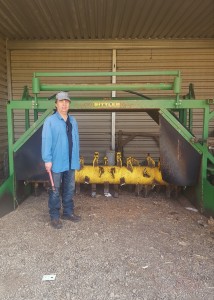This week we wanted to share a little bit about Christophe, our resident 
microbiologist and worm wrangler. Christophe and his wife Monique started off as customers but now lend their scientific backgrounds to help manage our thermofilic (compost made with heat loving bacteria) and Vermicompost (compost made with worms) programs which produce almost 5,000 tons of compost per year. Their work is invaluable to Frog Hollow Farm so let’s dig in!
Just like our bodies, each tree has its own eco-system. This includes the tree itself and the plants growing on the ground underneath along with birds, insects, bacteria, protozoa and fungus found in and around it. Some of these organisms are good for trees, they break down organic material to make it easier for roots to absorb and defend the tree against disease. Others can cause disease if they are allowed to run wild. To have a healthy tree and delicious fruit we have to keep this whole system happy, from the tree itself down to the tiniest micro-organisms.
Let’s take a moment to think about what makes trees happy. Christophe suggests imagining a very healthy old-growth forest. Under the thick canopy of green leaves you will find leaf litter, or duff, covering the ground. This is the forest’s way of recycling all the energy and nutrients it puts into leaves and fruit back down to its roots. Bacteria, protozoa and fungus (mushrooms), do the hard work of breaking down the duff so that the tree can absorb those nutrients from the soil.
We do our best to mimic these same forest conditions in our orchards with compost made  of fruit, kitchen food waste, shredded cardboard, tree trimmings, coffee and horse bedding. We put a higher proportion of woody material than a vegetable farmer might, which encourages fungal growth perfect for trees. Here you see one of our newest compost piles getting built. It has trimmings from winter pruning, shredded cardboard, the last of the warren pears from our fall harvest, and coffee grounds. This mixture is piled together and turned using the tractor attachment you see Christophe standing with above. It goes through each pile, rotating it to redistribute nutrients and those amazing micro organisms so they can continue digesting. To ensure any potential human pathogens in our compost are killed we have to make sure to bring the compost up to a minimum of 131 degrees and keep it there for 15 days. Once the compost is finished it is spread by our ground crew at the base of trees to start the process over again!
of fruit, kitchen food waste, shredded cardboard, tree trimmings, coffee and horse bedding. We put a higher proportion of woody material than a vegetable farmer might, which encourages fungal growth perfect for trees. Here you see one of our newest compost piles getting built. It has trimmings from winter pruning, shredded cardboard, the last of the warren pears from our fall harvest, and coffee grounds. This mixture is piled together and turned using the tractor attachment you see Christophe standing with above. It goes through each pile, rotating it to redistribute nutrients and those amazing micro organisms so they can continue digesting. To ensure any potential human pathogens in our compost are killed we have to make sure to bring the compost up to a minimum of 131 degrees and keep it there for 15 days. Once the compost is finished it is spread by our ground crew at the base of trees to start the process over again!
Stay tuned to hear more about how we’ve taken compost to the next level with worms!

 Follow
Follow
